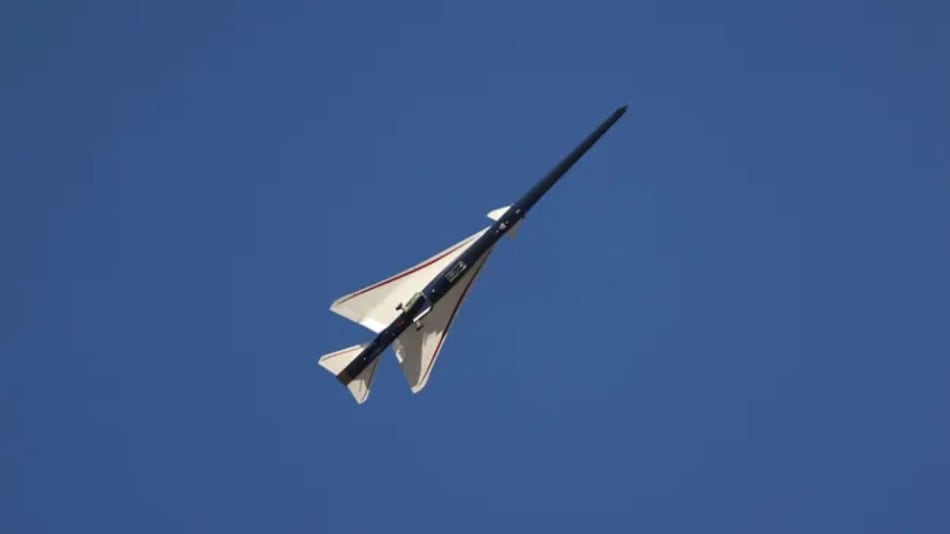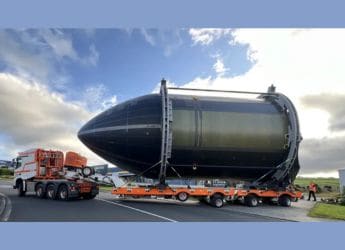- Home
- Science
- Science News
- NASA’s X 59 Supersonic Jet Takes Historic First Flight, Paving Way for Quiet Supersonic Travel
NASA’s X-59 Supersonic Jet Takes Historic First Flight, Paving Way for Quiet Supersonic Travel
NASA’s X-59 supersonic jet completes first flight, testing quiet sonic technology.

Photo Credit: Jarod Hamilton
NASA’s X-59 jet flies over California, marking a milestone in quiet supersonic flight.
NASA's experimental X-59 supersonic jet has taken to the skies for the first time, nearly 30 years after its initial conception. Albeit in a somewhat more rudimentary form than we'll eventually see flying over U.S. cities. Some pioneering engineering work from Lockheed Martin and others over the course of several decades laid much of today's “sonic boom” regulations in order to get us here. The aircraft, a needle-nosed vehicle, soared over California's Palmdale Regional Airport at 10:13 a.m. EDT (1413 GMT) on Oct. 28 during an approximately hour-long test flight. It is specially designed to pierce the sound barrier in a way that doesn't disturb the peace with deafening roars known as sonic booms, although the X-59 could offer routine supersonic travel across land. For instance, from New York to Los Angeles, which has been banned over the United States since 1973.
NASA's X-59 Begins Next Testing Phase After Historic Flight, Aiming to Prove Quiet Supersonic Travel
As per a Space.com report, the X-59 took off from the U.S. Air Force's Plant 42 facility before flying over Edwards Air Force Base, where NASA's Armstrong Flight Research Center is located. Aircraft tracker data showed the plane completing oval-shaped “racetrack” patterns for over an hour before landing. NASA has not yet released an official statement, possibly due to the ongoing U.S. government shutdown, though photos and videos captured by spotters confirmed the event.
Designed by NASA and built by Lockheed Martin's Skunk Works division, the X-59 represents a decade-long effort to minimise the loud shockwaves that accompany supersonic travel. Engineers shaped the jet's elongated nose and specialised airframe to convert thunderous sonic booms into a soft “thump” that would be barely audible on the ground.
NASA testing of the X-59 at its Armstrong Center will study shockwaves to evaluate safety concerns related to quiet supersonic flight. The X-59, experts believe, could help to resuscitate supersonic travel, shaving air time and bringing to the forefront NASA's aspirations for sustainable aviation that is less of a pain in the ears.
Get your daily dose of tech news, reviews, and insights, in under 80 characters on Gadgets 360 Turbo. Connect with fellow tech lovers on our Forum. Follow us on X, Facebook, WhatsApp, Threads and Google News for instant updates. Catch all the action on our YouTube channel.
Related Stories
- Samsung Galaxy Unpacked 2025
- ChatGPT
- Redmi Note 14 Pro+
- iPhone 16
- Apple Vision Pro
- Oneplus 12
- OnePlus Nord CE 3 Lite 5G
- iPhone 13
- Xiaomi 14 Pro
- Oppo Find N3
- Tecno Spark Go (2023)
- Realme V30
- Best Phones Under 25000
- Samsung Galaxy S24 Series
- Cryptocurrency
- iQoo 12
- Samsung Galaxy S24 Ultra
- Giottus
- Samsung Galaxy Z Flip 5
- Apple 'Scary Fast'
- Housefull 5
- GoPro Hero 12 Black Review
- Invincible Season 2
- JioGlass
- HD Ready TV
- Laptop Under 50000
- Smartwatch Under 10000
- Latest Mobile Phones
- Compare Phones
- Redmi Note 15 5G
- Redmi Note 15 Pro 5G
- Redmi Note 15 Pro+ 5G
- Lava Play Max
- Poco C85 5G
- Honor Magic 8 Lite
- Jolla Phone
- Realme P4x 5G
- Asus ProArt P16
- MacBook Pro 14-inch (M5, 2025)
- OnePlus Pad Go 2
- Poco Pad M1
- Just Corseca Skywatch Pro
- Honor Watch X5
- Acerpure Nitro Z Series 100-inch QLED TV
- Samsung 43 Inch LED Ultra HD (4K) Smart TV (UA43UE81AFULXL)
- Asus ROG Ally
- Nintendo Switch Lite
- Haier 1.6 Ton 5 Star Inverter Split AC (HSU19G-MZAID5BN-INV)
- Haier 1.6 Ton 5 Star Inverter Split AC (HSU19G-MZAIM5BN-INV)

















